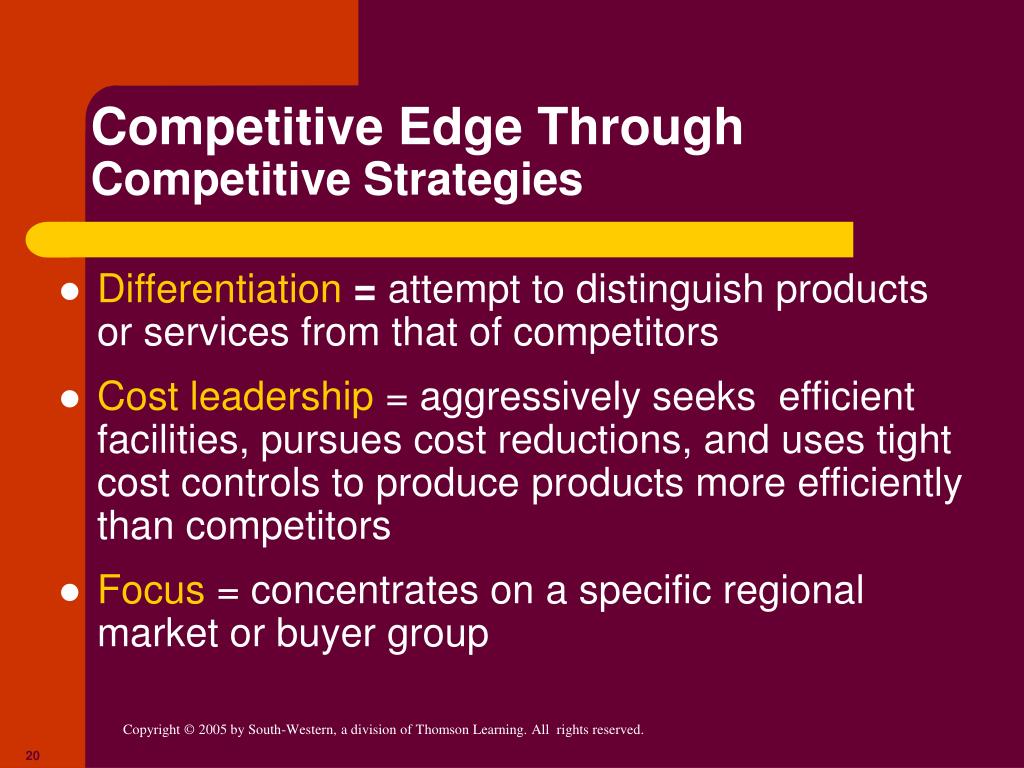Competitive advantage growth is the holy grail for any business seeking sustained success. This exploration delves into the multifaceted nature of achieving and maintaining a competitive edge, examining both internal strengths and external market forces. We will dissect key strategies, analyze successful case studies, and offer practical insights to help businesses not only achieve growth but also ensure its longevity. Understanding the dynamics of competitive advantage is crucial in today’s dynamic marketplace, and this guide provides a roadmap for navigating this complex terrain.
From identifying core components of competitive advantage to developing actionable strategies for cultivation and maintenance, this analysis provides a comprehensive framework. We’ll explore diverse approaches, including cost leadership, differentiation, and niche market strategies, offering a practical and insightful examination of how businesses can build and sustain a competitive edge for long-term success. Real-world examples and hypothetical scenarios will illuminate the concepts, making the information readily applicable to various business contexts.
Defining Competitive Advantage Growth

Competitive advantage growth refers to the sustained increase in a company’s market share and profitability resulting from its ability to outperform competitors. It’s not simply about making more money; it’s about building a resilient and expanding position within the market based on unique strengths. This involves both developing and leveraging a competitive advantage while simultaneously adapting to changing market dynamics.
Core Components of Competitive Advantage
A competitive advantage is built upon several key components. These include superior resources and capabilities (such as proprietary technology, skilled workforce, strong brand reputation), a clear understanding of target customer needs, and the ability to efficiently deliver value to those customers. A strong competitive advantage often translates into higher profit margins, greater market share, and increased customer loyalty, all of which fuel growth. For example, a company with a patented manufacturing process enjoys a cost advantage, while a company with a powerful brand commands premium pricing. The interaction and synergy between these components are crucial for sustained competitive advantage.
Factors Influencing Growth in a Competitive Landscape, Competitive advantage growth
Several factors significantly impact a company’s ability to achieve competitive advantage growth. These include market demand, technological advancements, competitive intensity, regulatory changes, and macroeconomic conditions. Rapid technological change, for instance, can quickly render a previously successful competitive advantage obsolete, necessitating constant innovation and adaptation. Similarly, increased competition can erode profit margins, forcing companies to find new ways to differentiate themselves. Conversely, favorable macroeconomic conditions, such as strong economic growth, can create opportunities for expansion and increased profitability.
Examples of Businesses with Successful Competitive Advantage Growth
Apple’s sustained success exemplifies competitive advantage growth through a combination of design innovation, brand loyalty, and a tightly integrated ecosystem of products and services. Their focus on user experience and premium pricing has enabled them to maintain high profit margins despite intense competition. Similarly, Amazon’s dominance in e-commerce stems from its efficient logistics network, vast product selection, and customer-centric approach. Their early adoption of technology and relentless focus on operational efficiency have fueled their remarkable growth. Finally, Netflix’s success in streaming demonstrates the power of adapting to changing consumer preferences and leveraging technological advancements. Their early move into online streaming allowed them to capture a significant market share and establish a strong brand presence.
Comparison of Competitive Advantage Strategies
| Strategy | Focus | Key Characteristics | Example |
|---|---|---|---|
| Cost Leadership | Lowest production and distribution costs | High efficiency, economies of scale, cost control | Walmart |
| Differentiation | Unique product or service features | High quality, brand recognition, innovation | Apple |
| Niche Market | Specialized product or service for a specific segment | Strong customer relationships, deep market knowledge | Tesla (initially) |
| Focus (Cost or Differentiation) | Cost leadership or differentiation within a specific niche | Combination of cost leadership and differentiation strategies within a defined market segment | Luxury car brands focusing on a particular style |
Analyzing Sources of Competitive Advantage

Understanding the origins of a company’s competitive edge is crucial for sustained growth. A robust competitive advantage stems from a complex interplay of internal capabilities and external market dynamics. Analyzing these factors allows businesses to strategically allocate resources and optimize their performance for long-term success.
Three key internal resources significantly contribute to a company’s competitive advantage. These resources, when effectively managed, can create a powerful and sustainable barrier to entry for competitors.
Key Internal Resources Contributing to Competitive Advantage
Identifying and leveraging internal strengths is paramount for achieving a competitive advantage. These strengths often manifest as tangible and intangible assets within the organization.
Competitive advantage growth hinges on efficient operations and a strong online presence. A key component of this is a robust e-commerce platform, and selecting the right Shopping cart software is crucial. The right software streamlines sales processes, improves customer experience, and ultimately fuels significant competitive advantage growth, leading to increased market share and profitability.
- Strong Brand Reputation: A well-established brand enjoys high customer loyalty and trust, translating into greater market share and pricing power. For example, companies like Apple benefit from a strong brand image that allows them to command premium prices for their products.
- Proprietary Technology: Unique technologies, patents, or processes provide a significant competitive edge. Pharmaceutical companies, for instance, rely heavily on patented drug formulations to maintain market dominance.
- Highly Skilled Workforce: A team of highly skilled and experienced employees is invaluable. Their expertise and dedication contribute to innovation, efficiency, and superior product/service quality. Consulting firms, for example, often base their competitive advantage on the expertise of their consultants.
The Role of Innovation in Driving Competitive Advantage Growth
Innovation is not merely a desirable trait; it’s a critical driver of sustained competitive advantage. Continuous innovation allows companies to adapt to changing market demands, create new product categories, and improve existing offerings.
Companies that consistently innovate often experience faster growth rates and higher profitability. For example, Tesla’s continuous innovation in battery technology and electric vehicle design has allowed them to disrupt the automotive industry and establish a significant market position.
Sustained competitive advantage growth often hinges on innovation and strategic resource allocation. Understanding market dynamics is crucial, and sometimes, even seemingly unrelated activities can offer valuable insights. For instance, analyzing the strategic decision-making involved in a game like Permainan perang kapal laut can illuminate the complexities of resource management and competitive positioning, ultimately informing broader business strategies for achieving long-term competitive advantage.
Impact of External Factors on Competitive Advantage
External factors, while outside a company’s direct control, significantly influence its competitive landscape. Adaptability and strategic foresight are essential for navigating these challenges and opportunities.
Market trends, such as shifting consumer preferences or the emergence of new technologies, can dramatically alter the competitive landscape. Regulations, such as environmental standards or trade policies, can also significantly impact a company’s operations and profitability. For instance, the rise of e-commerce significantly impacted brick-and-mortar retailers, forcing many to adapt their business models or face decline. Similarly, new environmental regulations can necessitate significant investments in cleaner technologies for companies in polluting industries.
Hypothetical Scenario: Leveraging Strengths for Growth
Imagine a mid-sized coffee roaster, “AromaBrew,” with a strong reputation for ethically sourced beans and a highly skilled team of coffee experts. AromaBrew’s competitive advantage lies in its superior quality and commitment to sustainability. To achieve further growth, AromaBrew could leverage its strengths in several ways:
AromaBrew could expand its product line by introducing new coffee blends and specialty coffee drinks tailored to emerging consumer preferences, such as plant-based milk options or unique flavor profiles. They could also leverage their strong brand reputation to launch a line of premium coffee accessories or open a chain of high-end coffee shops, capitalizing on the established trust and loyalty of their customer base. This expansion strategy would capitalize on their existing strengths (quality, sustainability, and brand reputation) to reach new markets and increase revenue streams.
Strategies for Cultivating Competitive Advantage

Building a sustainable competitive advantage requires a proactive and strategic approach. It’s not merely about being better than the competition; it’s about creating a position that’s difficult to replicate and consistently delivers superior value to customers. This involves understanding your market, leveraging your strengths, and constantly adapting to changing dynamics.
Five Practical Strategies for Building Sustainable Competitive Advantage
Developing a sustainable competitive advantage necessitates a multifaceted approach. The following strategies represent key pillars for achieving and maintaining a superior market position.
- Innovation: Continuously developing new products, services, or processes that offer superior value to customers. This could involve technological advancements, improved design, or enhanced functionality. For example, Apple’s consistent innovation in smartphone technology has allowed them to maintain a strong competitive advantage.
- Operational Excellence: Streamlining operations to achieve higher efficiency, lower costs, and faster delivery times. This could involve implementing lean manufacturing techniques, optimizing supply chains, or leveraging advanced technology. Toyota’s lean manufacturing system is a prime example of operational excellence driving competitive advantage.
- Customer Intimacy: Building strong relationships with customers by understanding their needs and providing personalized service. This fosters loyalty and repeat business, creating a barrier to entry for competitors. Companies like Nordstrom, known for exceptional customer service, exemplify this strategy.
- Brand Building: Creating a strong and recognizable brand that resonates with customers and conveys a sense of trust and quality. This requires consistent messaging, effective marketing, and a commitment to delivering on brand promises. Coca-Cola’s globally recognized brand is a testament to the power of brand building.
- Strategic Alliances: Partnering with other companies to access new markets, technologies, or resources. This can provide a competitive edge by leveraging the strengths of multiple organizations. For instance, many tech companies form strategic alliances to integrate their products and services.
Comparison of Market Penetration and Expansion Approaches
Market penetration and expansion strategies represent distinct approaches to growth. Market penetration focuses on increasing sales of existing products to existing customers, while market expansion involves targeting new markets or customer segments with either existing or new products.
| Strategy | Description | Example |
|---|---|---|
| Market Penetration | Increasing market share within existing markets using existing products. This might involve price reductions, enhanced marketing, or improved product features. | A coffee shop offering loyalty programs to increase repeat purchases from existing customers. |
| Market Development | Expanding into new geographic markets or customer segments with existing products. | A clothing retailer opening new stores in different regions of the country. |
| Product Development | Introducing new products to existing markets. | A software company releasing a new version of its software with enhanced features. |
| Diversification | Expanding into new markets with new products. This is the riskiest approach, but it can offer significant growth opportunities. | A food company launching a new line of organic snacks targeting health-conscious consumers. |
Step-by-Step Plan for Implementing a Competitive Advantage Strategy
Successful implementation requires a structured approach. A step-by-step plan ensures a focused and effective execution of the chosen strategy.
- Define the Competitive Advantage: Clearly articulate the unique value proposition and how it differentiates the company from competitors.
- Conduct a SWOT Analysis: Assess internal strengths and weaknesses, as well as external opportunities and threats.
- Develop a Strategic Plan: Artikel specific goals, objectives, and tactics for achieving the competitive advantage.
- Allocate Resources: Secure necessary funding, personnel, and other resources to support the plan’s execution.
- Implement the Plan: Put the strategy into action, monitoring progress and making adjustments as needed.
- Evaluate and Adapt: Regularly assess the effectiveness of the strategy and make changes based on performance data and market feedback.
Enhancing Competitive Advantage Through Effective Marketing
Effective marketing plays a crucial role in building and maintaining a competitive advantage. It’s about more than just advertising; it’s about creating a compelling brand story, communicating value to customers, and building lasting relationships.
Effective marketing helps to build brand awareness, establish a strong brand identity, and create a loyal customer base, all of which contribute to a sustainable competitive advantage.
Measuring and Maintaining Competitive Advantage
Sustaining a competitive advantage requires more than just identifying and implementing winning strategies; it necessitates continuous monitoring and adaptation. Regularly measuring performance against key indicators and closely observing the competitive landscape are crucial for long-term success. This section explores methods for tracking progress, monitoring competitors, and adapting strategies to maintain a leading position in the market.
Effective measurement is the cornerstone of maintaining a competitive edge. Without quantifiable data, it’s difficult to assess the efficacy of strategies and identify areas needing improvement. This involves selecting appropriate Key Performance Indicators (KPIs) and establishing a robust monitoring system.
Key Performance Indicators for Competitive Advantage Growth
Choosing the right KPIs depends heavily on the specific industry and business model. However, some universally applicable indicators provide valuable insights into competitive advantage. These metrics offer a clear picture of the company’s performance relative to its competitors and the overall market.
- Market Share: A fundamental indicator reflecting the company’s dominance within its target market. A consistent increase suggests a strong competitive position.
- Customer Acquisition Cost (CAC): Measures the efficiency of acquiring new customers. Lower CAC compared to competitors indicates a more effective marketing and sales strategy.
- Customer Lifetime Value (CLTV): Represents the total revenue generated by a single customer over their relationship with the company. A higher CLTV signifies stronger customer loyalty and retention.
- Brand Equity: Reflects the perceived value and reputation of the brand. Strong brand equity translates to higher customer loyalty and pricing power.
- Profit Margins: Illustrate the company’s profitability relative to its costs. Higher margins than competitors point to a more efficient operation and pricing strategy.
Monitoring Competitor Activities and Market Dynamics
Staying ahead of the curve demands constant vigilance regarding competitor actions and market shifts. Effective monitoring involves a multi-faceted approach, combining various data sources and analytical techniques.
Competitor analysis should include reviewing their marketing strategies, product launches, pricing policies, and expansion plans. This information can be gathered through publicly available resources like annual reports, news articles, and industry publications. Furthermore, market research firms often provide detailed competitive landscapes. Analyzing these factors helps companies anticipate potential threats and identify opportunities to strengthen their position. Understanding broader market trends, such as technological advancements, regulatory changes, and shifts in consumer preferences, is equally crucial. This allows for proactive adjustments to maintain relevance and competitiveness.
Adapting Strategies to Maintain a Competitive Edge
Maintaining a competitive edge requires ongoing adaptation and innovation. Companies must be agile enough to respond to changing market conditions and competitor actions. This might involve adjusting pricing strategies, enhancing product offerings, improving customer service, or investing in new technologies.
For example, Netflix’s shift from DVD rentals to streaming services demonstrated a successful adaptation to changing consumer preferences and technological advancements. Similarly, the rise of e-commerce forced many brick-and-mortar retailers to integrate online channels into their business models. These examples highlight the importance of proactive adaptation to stay competitive.
Proactive Measures to Address Potential Threats
A proactive approach to risk management is vital in preserving competitive advantage. Regularly assessing potential threats and developing mitigation strategies is essential for long-term success.
- Regularly conduct SWOT analyses: Identifying strengths, weaknesses, opportunities, and threats allows for a comprehensive assessment of the company’s competitive position.
- Invest in research and development: Continuous innovation is crucial for staying ahead of competitors and meeting evolving customer needs.
- Develop strong customer relationships: Loyal customers are less susceptible to competitor offers, providing a buffer against market fluctuations.
- Build a resilient supply chain: A robust supply chain ensures consistent product availability and reduces vulnerability to disruptions.
- Monitor regulatory changes: Staying informed about impending regulations allows companies to adapt their operations and avoid potential penalties.
- Cultivate a culture of adaptability: A flexible and responsive organizational structure is essential for navigating unexpected challenges and capitalizing on emerging opportunities.
Case Studies: Competitive Advantage Growth

This section examines a successful case study illustrating competitive advantage growth, analyzing its approach, challenges, and long-term implications. We will explore how a company strategically leveraged its resources and capabilities to achieve sustained competitive advantage and what lessons can be learned from their journey.
Apple’s Competitive Advantage Growth
Apple’s remarkable success story serves as a compelling case study in cultivating and maintaining a powerful competitive advantage. Their strategy has centered on a tightly integrated ecosystem of hardware, software, and services, creating a unique user experience that fosters brand loyalty and drives significant growth. This ecosystem effect, where the value of each component is enhanced by its interaction with others, has been a key driver of their competitive advantage.
Challenges Faced and Overcome by Apple
Apple has faced numerous challenges throughout its history. Early on, they struggled with maintaining consistent product quality and managing supply chains. More recently, they’ve encountered intensifying competition from Android-based smartphones and increasing scrutiny regarding their business practices. They’ve addressed these challenges through continuous innovation, a relentless focus on design and user experience, aggressive marketing campaigns, and strategic acquisitions that strengthened their ecosystem. Furthermore, they successfully navigated controversies by adapting their strategies and communicating proactively with stakeholders.
Insights on Maintaining Long-Term Competitive Advantage: Apple’s Approach
Apple’s sustained success highlights the importance of several key factors in maintaining long-term competitive advantage. Firstly, a strong emphasis on innovation and a culture of continuous improvement are paramount. Secondly, building a robust and loyal customer base through exceptional user experience is crucial. Thirdly, strategically managing the entire value chain, from design and manufacturing to distribution and customer service, ensures efficient operations and high-quality products. Finally, adapting to changing market conditions and proactively addressing challenges are essential for long-term survival and growth. Apple’s consistent focus on these elements has enabled them to maintain their dominant position in the tech industry.
Visual Representation of Apple’s Strategy
Imagine a Venn diagram with three overlapping circles. The first circle represents “Hardware” (e.g., iPhones, Macs, iPads). The second circle represents “Software” (e.g., iOS, macOS, watchOS). The third circle represents “Services” (e.g., App Store, Apple Music, iCloud). The overlapping areas represent the synergistic effects of these elements. The largest overlapping area, where all three circles intersect, is labeled “Ecosystem Advantage.” Arrows point from each circle and the intersection to a central point labeled “Customer Loyalty & Revenue Growth.” This visual clearly depicts how the integration of hardware, software, and services creates a powerful ecosystem that drives customer loyalty and revenue growth, which are the core components of Apple’s sustained competitive advantage.
Conclusive Thoughts
Ultimately, achieving and sustaining competitive advantage growth requires a holistic approach that integrates strategic planning, operational excellence, and a deep understanding of market dynamics. By leveraging internal resources, innovating effectively, and proactively addressing potential threats, businesses can not only achieve significant growth but also ensure the long-term viability of their competitive position. The journey demands continuous monitoring, adaptation, and a commitment to exceeding customer expectations in a constantly evolving marketplace. This analysis provides a foundation for businesses to embark on this journey with confidence and foresight.